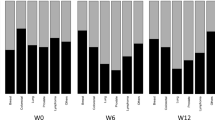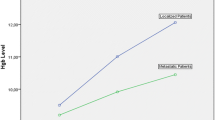Abstract
Background
Pharmacological ascorbate (intravenous delivery reaching plasma concentrations ≈ 20 mM; P-AscH−) has emerged as a promising therapeutic strategy for glioblastoma. Recently, a single-arm phase 2 clinical trial demonstrated a significant increase in overall survival when P-AscH− was combined with temozolomide and radiotherapy. As P-AscH− relies on iron-dependent mechanisms, this study aimed to assess the predictive potential of both molecular and imaging-based iron-related markers to enhance the personalization of P-AscH− therapy in glioblastoma participants.
Methods
Participants (n = 55) with newly diagnosed glioblastoma were enrolled in a phase 2 clinical trial conducted at the University of Iowa (NCT02344355). Tumor samples obtained during surgical resection were processed and stained for transferrin receptor and ferritin heavy chain expression. A blinded pathologist performed pathological assessment. Quantitative susceptibility mapping (QSM) measures were obtained from pre-radiotherapy MRI scans following maximal safe surgical resection. Circulating blood iron panels were evaluated prior to therapy through the University of Iowa Diagnostic Laboratory.
Results
Through univariate analysis, a significant inverse association was observed between tumor transferrin receptor expression and overall and progression-free survival. QSM measures exhibited a significant, positive association with progression-free survival. Subjects were actively followed until disease progression and then were followed through chart review or clinical visits for overall survival.
Conclusions
This study analyzes iron-related biomarkers in the context of P-AscH− therapy for glioblastoma. Integrating molecular, systemic, and imaging-based markers offers a multifaceted approach to tailoring treatment strategies, thereby contributing to improved patient outcomes and advancing the field of glioblastoma therapy.
Highlights
-
Pharmacological ascorbate shows significant promise to enhance glioblastoma clinical outcomes.
-
Transferrin receptor and ferritin heavy chain expression represent potential molecular markers to predict pharmacological ascorbate treatment response.
-
Quantitative Susceptibility Mapping is an MRI technique that can serve as a non-invasive marker of iron metabolism to evaluate progression-free survival.
-
Systemic iron metabolic markers are readily available diagnostic tests that can potentially be used to prognosticate overall survival.


Similar content being viewed by others
Data availability
No datasets were generated or analysed during the current study.
References
Wen PY, Kesari S (2008) Malignant gliomas in adults. N Engl J Med 359:492–507
Stupp R et al (2005) Radiotherapy plus concomitant and adjuvant temozolomide for glioblastoma. N Engl J Med 352:987–996
Ostrom QT, Cioffi G, Waite K, Kruchko C, Barnholtz-Sloan JS (2021) CBTRUS Statistical Report: primary brain and other Central Nervous System tumors diagnosed in the United States in 2014–2018. Neurooncology 23:iii1–iii105
Schonberg DL et al (2015) Preferential Iron trafficking characterizes glioblastoma stem-like cells. Cancer Cell 28:441–455
Harrison PM, Arosio P (1996) The ferritins: molecular properties, iron storage function and cellular regulation. Biochim et Biophys Acta (BBA) - Bioenergetics 1275:161–203
Tabu K, Taga T (2022) Cancer ego-system in glioma: an iron-replenishing niche network systemically self-organized by cancer stem cells. Inflamm Regeneration 42:54
Schoenfeld JD et al (2017) O2⋅– and H2O2-Mediated disruption of Fe Metabolism causes the Differential susceptibility of NSCLC and GBM Cancer cells to pharmacological ascorbate. Cancer Cell 31:487–500e8
Buettner GR, Jurkiewicz BA (1996) Catalytic metals, ascorbate and free radicals: combinations to avoid. Radiat Res 145:532–541
Bielski BHJ (1982) Chemistry of ascorbic acid radicals. In: Ascorbic acid: chemistry, metabolism, and uses, vol 200. American Chemical Society, pp 81–100
Schoenfeld JD et al (2018) Redox active metals and H2O2 mediate the increased efficacy of pharmacological ascorbate in combination with gemcitabine or radiation in pre-clinical sarcoma models. Redox Biol 14:417–422
Petronek MS et al (2023) Magnetic resonance imaging of iron metabolism with T2* mapping predicts an enhanced clinical response to pharmacological ascorbate in patients with GBM. Clin Cancer Res. https://doi.org/10.1158/1078-0432.CCR-22-3952
Liu C et al (2015) Quantitative susceptibility mapping: contrast mechanisms and clinical applications. Tomography 1:3–17
Langkammer C et al (2012) Quantitative susceptibility mapping (QSM) as a means to measure brain iron? A post mortem validation study. NeuroImage 62:1593–1599
Bilgic B, Pfefferbaum A, Rohlfing T, Sullivan EV, Adalsteinsson E (2012) MRI estimates of brain iron concentration in normal aging using quantitative susceptibility mapping. NeuroImage 59:2625–2635
Mochizuki H, Yasuda T (2012) Iron accumulation in Parkinson’s disease. J Neural Transm 119:1511–1514
Allen BG et al (2019) First-in-human phase I clinical trial of pharmacologic ascorbate combined with Radiation and Temozolomide for newly diagnosed Glioblastoma. Clin Cancer Res 25:6590–6597
Langkammer C et al (2015) Fast quantitative susceptibility mapping using 3D EPI and total generalized variation. NeuroImage 111:622–630
Rosager AM et al (2017) Transferrin receptor-1 and ferritin heavy and light chains in astrocytic brain tumors: expression and prognostic value. PLoS ONE 12:e0182954
Müllner EW, Kühn LC (1988) A stem-loop in the 3′ untranslated region mediates iron-dependent regulation of transferrin receptor mRNA stability in the cytoplasm. Cell 53:815–825
Cairo G, Pietrangelo A (1994) Transferrin receptor gene expression during rat liver regeneration. Evidence for post-transcriptional regulation by iron regulatory factorB, a second iron-responsive element-binding protein. J Biol Chem 269:6405–6409
Brandt KE et al (2018) Augmentation of intracellular iron using iron sucrose enhances the toxicity of pharmacological ascorbate in colon cancer cells. Redox Biol 14:82–87
Petronek MS et al (2023) Magnetite nanoparticles as a kinetically favorable source of iron to enhance GBM response to chemoradiosensitization with pharmacological ascorbate. Redox Biol 62:102651
Funding
This work was supported by the Gateway for Cancer Research grant G-17-1500 and NIH grants P01 CA217797 and R21 CA270742. Core facilities were supported in part by the Carver College of Medicine and the Holden Comprehensive Cancer Center, NIH P30 CA086862.
Author information
Authors and Affiliations
Contributions
Conception and design: MSP, KLB, KAJ, JMB, VAM, BGA. Data collection and analysis: MSP, KLB, BGA, CYL, NT, KLE, BTL, BJS. Data curation and preparation: MSP, CYL, KLE, BTL. All authors edited and approved the final version of this manuscript prior to submission.
Corresponding author
Ethics declarations
Competing interests
The authors declare no competing interests.
Additional information
Publisher’s Note
Springer Nature remains neutral with regard to jurisdictional claims in published maps and institutional affiliations.
Rights and permissions
About this article
Cite this article
Petronek, M.S., Bodeker, K.L., Lee, C.Y. et al. Iron-based biomarkers for personalizing pharmacological ascorbate therapy in glioblastoma: insights from a phase 2 clinical trial. J Neurooncol 166, 493–501 (2024). https://doi.org/10.1007/s11060-024-04571-z
Received:
Accepted:
Published:
Issue Date:
DOI: https://doi.org/10.1007/s11060-024-04571-z




